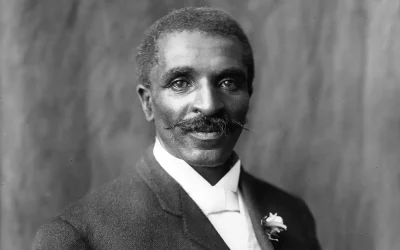George Washington Carver was an agricultural scientist and inventor who developed hundreds of products using peanuts, sweet potatoes, and soybeans, substantially improving the agricultural economy of the American South. Born into slavery, Carver pursued education and earned a master’s degree in agricultural science. He taught and conducted research at Tuskegee University for decades, and his work continues to inspire generations.
Early life
Born on a farm near Diamond, Missouri, the exact date of Carver’s birth is unknown, but it is believed to be in January or June of 1864. George’s mother, Mary, was purchased by Moses Carver, a white farm owner who was against slavery but needed help on his 240-acre farm.
During the Civil War, infant George, his mother, and his sister were kidnapped by slave raiders and sold in Kentucky. Moses Carver managed to retrieve George by trading one of his finest horses but could not find Mary. George and his brother James were raised by Moses and his wife Susan, who taught them to read and write.
Due to his frail health, George could not work the fields like his brother. Instead, Susan taught him various domestic skills, and he developed an early interest in plants. His ability to improve the health of gardens, fields, and orchards earned him the nickname “the plant doctor.”
Education and pursuit of knowledge
At age 11, Carver left the farm to attend an all-Black school in Neosho, where he stayed with a childless Black couple, Andrew and Mariah Watkins. Mariah, a midwife and nurse, imparted her knowledge of medicinal herbs and devout faith upon George.
Dissatisfied with the education he received in Neosho, Carver moved to Kansas and continued his education through various occupations. He graduated from Minneapolis High School in Minneapolis, Kansas, in 1880. He was initially accepted at the all-white Highland College in Kansas, but his acceptance was rescinded when the administration learned he was Black.
Carver later enrolled in Simpson College, a Methodist school in Iowa, where he studied art and piano. One of his professors, Etta Budd, encouraged him to pursue botany and apply to Iowa State Agricultural School (now Iowa State University) to study agriculture.
In 1894, Carver became the first African American to earn a Bachelor of Science degree. Impressed by his research on fungal infections in soybean plants, his professors asked him to stay on for graduate studies. He earned his Master of Agriculture degree in 1896 and received an offer from Booker T. Washington to work at Tuskegee Institute (now Tuskegee University) in Alabama.
Tuskegee Institute and agricultural innovations

Carver’s early years at Tuskegee were challenging, as agriculture training was not popular among Southern farmers and students. Additionally, many faculty members resented Carver for his high salary and demand for two dormitory rooms. Despite these obstacles, Carver made significant contributions to agricultural research and education.
Carver taught poor farmers alternative methods, such as using acorns to feed hogs and swamp muck as fertiliser. His most valuable contribution was the promotion of crop rotation. By growing nitrogen-fixing plants like peanuts, soybeans, and sweet potatoes, depleted soil could be restored, and cotton yield increased dramatically.
To further assist farmers, Carver invented the Jessup wagon, a mobile (horse-drawn) classroom and laboratory used to demonstrate soil chemistry.
The peanut revolution
Carver’s crop rotation technique led to a surplus of peanuts and other non-cotton products. Determined to find alternative uses for these crops, Carver developed more than 300 food, industrial, and commercial products from peanuts, including milk, Worcestershire sauce, cooking oils, paper, cosmetics, soaps, and wood stains. He also experimented with peanut-based medicines, such as antiseptics, laxatives, and goitre medications.
In 1921, Carver testified before the US House of Representatives on behalf of the peanut industry, advocating for tariff protection. His testimony led to a standing ovation and the approval of a high protected tariff for peanuts, earning him the nickname “The Peanut Man.”
Fame, legacy, and humanitarian efforts
His dedication to serving humanity marked Carver’s later life. He travelled to the South to promote racial harmony and visited India to discuss nutrition with Mahatma Gandhi. He also released 44 bulletins for the public between 1898 and 1943, providing valuable information on agriculture, science, and practical applications for farmers, teachers, and housewives.
In the mid-1930s, Carver became convinced that peanuts could help combat polio. He offered peanut oil massages and reported positive results, though no scientific evidence supports these claims.
Carver passed away on 5 January 1943 at Tuskegee Institute. After his death, President Franklin D. Roosevelt signed legislation for Carver to receive a national monument, making him the first Black American to be honoured in this way. The George Washington Carver National Monument now stands in Diamond, Missouri, and Carver was posthumously inducted into the National Inventors Hall of Fame.
Inspirational quotes
Carver’s wisdom continues to inspire generations. Some of his most notable quotes include:
“Where there is no vision, there is no hope.”
“How far you go in life depends on your being tender with the young, compassionate with the aged, sympathetic with the striving and tolerant of the weak and strong. Because someday in your life you will have been all of these.”
“When you can do the common things of life in an uncommon way, you will command the attention of the world.”
George Washington Carver’s life and work remain a testament to his perseverance, innovation, and commitment to helping others. His groundbreaking agricultural research and inventions significantly improved the lives of farmers and the economy of the American South. Carver’s legacy serves as a reminder of the power of education, hard work, and the pursuit of knowledge in overcoming obstacles and creating a better world.






Leave a Reply